
Spring Hill is the name of a ridge in the central part of the city of Somerville, Massachusetts, United States, and the residential neighborhood that sits atop it. It runs northwest to southeast, roughly bounded by Highland Avenue, Somerville Avenue, Elm Street, and Willow Avenue. Summer Street runs along the hill's crest.
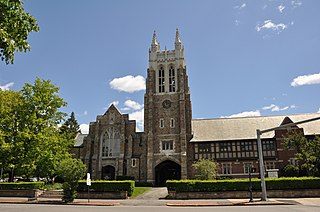
The First Unitarian Universalist Society in Newton occupies a prominent location at 1326 Washington Street in the heart of the village of West Newton in Newton, Massachusetts. Architect Ralph Adams Cram designed the church, Frederick Law Olmsted Jr. designed the grounds, the cornerstone was laid in 1905, and it was dedicated in 1906; it is one of the village's oldest buildings. The church is in Cram's signature Gothic Revival style, with buttressed walls and a blocky square tower with crenellations and spires. An enclosed courtyard is formed by an office wing, banquet hall, and parish house, which are built to resemble Elizabethan architecture with brick first floor and half-timbered upper level.
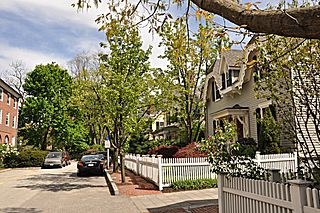
The Ash Street Historic District Cambridge, Massachusetts is a residential historic district on Ash Street and Ash Street Place between Brattle and Mount Auburn Streets in Cambridge, Massachusetts, off Brattle Street just west of Harvard Square. The district consists of ten well-preserved houses, most of which were built between 1850 and 1890. The district was listed on the National Register of Historic Places in 1982.

The Berkeley Street Historic District is a historic district on Berkeley Street and Berkeley Place in Cambridge, Massachusetts. It encompasses a neighborhood containing one of the greatest concentrations of fine Italianate and Second Empire houses in the city. It was listed on the National Register of Historic Places in 1982, with a substantial increase in 1986.

The East Cambridge Historic District encompasses the historic center of East Cambridge, Massachusetts. It includes the major buildings that were built to house county services for Middlesex County beginning in the 1810s, and a cluster of largely vernacular Greek Revival worker housing located west of the county complex on Otis, Thorndike, Spring, and Sciarappa Streets. The district was listed on the National Register of Historic Places in 1983.

The Follen Street Historic District is a historic district in Cambridge, Massachusetts, just northwest of the Cambridge Common. Follen Street is a quiet residential street, isolated from through streets by large masonry buildings that front on Waterford Street and Garden Street. All but three of the houses on the street were built no later than 1900, and show a remarkable quality of workmanship, despite being diverse in their styles. A number of the houses are specifically associated with educators, including a number of Harvard University professors. The Edwin Abbot House at 1 Follen Street is now the main building of the Longy School of Music of Bard College, and is separately listed on the National Register. Other houses listed separately include the Theodore W. Richards House at 15 Follen, the Second Waterhouse House at 9 Follen, and 10 Follen Street.
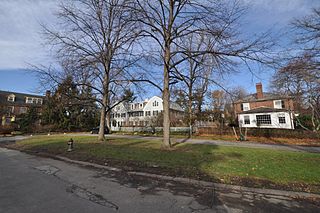
The Gray Gardens East and West Historic District is a historic district encompassing an early 20th century residential subdivision in Cambridge, Massachusetts. The subdivision includes all of the properties on Gray Gardens, as well as the adjacent 91 Garden Street and 60 Raymond Street. The subdivision was created by a group of interested individuals who sought to control development of one of the last estates in the area to be developed. They subdivided the land themselves, and imposed architectural restrictions on what could be built. Most of the houses were built between 1922 and 1930 and are neo-Georgian in style; the principal exception is the Hall Tavern, a Federal style tavern built in the 1790s and moved to the area from Duxbury, Massachusetts. The other unusual house is at 16 Gray Gardens East; it is a Tudor Revival house.

The Harvard Houses Historic District is a historic district encompassing seven of Harvard College's residential houses. The district is roughly bounded by Mt. Auburn, Grant, and Cowperwaite Streets, Banks Street and Putman Avenue, Memorial Drive, and JFK Street in Cambridge, Massachusetts. The contributing buildings to the district are predominantly residential dormitory buildings which were constructed between 1913 and 1930, and are Georgian Revival in style. There are three small residential buildings which were built in the 18th and 19th centuries, and a number of non-contributing later buildings, including among others the towers of Leverett House and the modern portion of Quincy House at 58 Plympton Street. The buildings are an imposing presence in the streetview of Memorial Drive between Western Avenue and the Anderson Memorial Bridge, but their massing is interrupted by mature tree plantings, and they are organized to provide courtyards and quadrangles in the interior of the district.

The Harvard Street Historic District is a historic district on Harvard Street between Ellery and Hancock Streets in Cambridge, Massachusetts. It includes houses on both sides of the street, numbered from 335 to 344 inclusive, an area that marks the summit of Dana Hill. Harvard Street was laid out as a direct route from "Old Cambridge" to Boston in the early 1800s, and was run over Dana Hill over the objection of Judge Francis Dana, whose estate sat on top of the hill. The street was developed over the 19th century with a succession of high-quality houses.

The Hastings Square Historic District is a historic district that encompasses Hastings Square, a small city park in Cambridge, Massachusetts, and the residential properties that abut it. The houses that line the streets across from the park are among the finest Queen Anne houses in the city. These properties were built between 1869 and 1892, and include two houses known to be designed by architects. The Queen Anne/Shingle style house at 302 Brookline Avenue was built in 1887 to a design by Rand & Taylor, and the 1892 Queen Anne house at 75 Henry Street was designed by Hartwell and Richardson.

The Memorial Drive Apartments Historic District is a historic district encompassing four apartment houses on Memorial Drive in Cambridge, Massachusetts. They are located between the Anderson Memorial Bridge and the Eliot Bridge with street numbers ranging from 983 to 993 Memorial Drive. All four buildings were built between 1916 and 1924, not long after Memorial Drive had been laid out, and were, despite significant similarities of style, designed by three different architects. All provide good views of the Charles River. The district was listed on the National Register of Historic Places in 1986.

The Salem–Auburn Streets Historic District is a residential historic district at Salem and Auburn Streets in Cambridge, Massachusetts. The district includes a collection of houses that is among the oldest in the Cambridgeport section of the city, and includes most of the houses on two blocks of these streets. The district was added to the National Register of Historic Places in 1982.

The Sugar Hill Historic District is a historic district in Detroit, Michigan. It contains 14 structures located along three streets: East Forest, Garfield, and East Canfield, between Woodward Avenue on the west and John R. on the east. The district was listed on the National Register of Historic Places in 2003.

The Wedgemere Historic District encompasses the largest single 19th-century residential development of Winchester, Massachusetts. It is one of the town's largest surviving 19th-century residential subdivisions, with a concentration of high-quality residences built between about 1890 and 1920. The district was listed on the National Register of Historic Places in 1989.
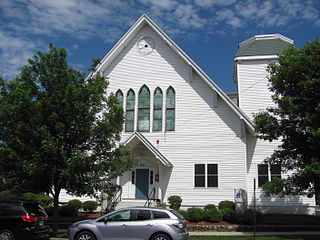
The First Unitarian Church is a historic former church building in Stoneham, Massachusetts. One of Stoneham's more stylish Gothic Revival buildings, the Stick style wood structure was built in 1869 for a Unitarian congregation that was organized in 1858. The building was listed on the National Register of Historic Places in 1984, and included in the Central Square Historic District in 1990. It presently houses the local Community Access Television organization.

The buildings at 35–37 Richardson Avenue are historic rowhouses in Wakefield, Massachusetts. These two rowhouses, built c. 1912–15, are among the earliest apartment blocks built in the town. They were built by Solon O. Richardson, Jr. on a portion of his estate. The buildings were listed on the National Register of Historic Places in 1989.

The Church–Lafayette Streets Historic District encompasses a well-preserved collection of late 18th- and early 19th-century houses in Wakefield, Massachusetts. It includes properties on Church Street between Common Street and North Avenue, and on Lafayette Street between Common and Church Streets. The district was added to the National Register of Historic Places in 1989.
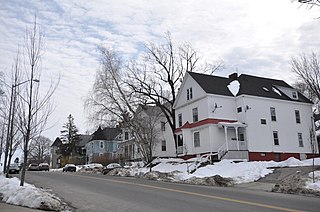
The May Street Historic District of Worcester, Massachusetts, encompasses a well-preserved collection of mid-19th century residences that are predominantly Queen Anne in their styling. The district, which was listed on the National Register of Historic Places in 1980, extends along May Street from Florence Street to just beyond Woodland Street, including houses numbered from 29 to 56 May Street.

The House at 5 Bennett Street in Wakefield, Massachusetts, is also known as the Wakefield House for Aged Women, and is one of the largest houses in Wakefield's Junction District. The original part of the house was built sometime between 1875 and 1881, with Italianate styling. It was probably built for an executive of the Wakefield Rattan Company. In 1894 the house was purchased by the Wakefield House for Aged Women, a charity established by local Protestant churches, and significantly expanded. During this major alteration some of the house's Italianate details were copied, and a Queen Anne style porch was added.

Hartwell and Richardson was a Boston, Massachusetts architectural firm established in 1881, by Henry Walker Hartwell (1833–1919) and William Cummings Richardson (1854–1935). The firm contributed significantly to the current building stock and architecture of the greater Boston area. Many of its buildings are listed on the National Register of Historic Places.























